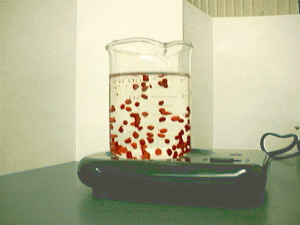Demonstration goals:
- Illustrate the motion of convection cells
- Demonstrate the effect of a boundary layer on convectionIf there is more heat in one place than another, then the heat can be transferred by one of three mechanisms:
- Radiation – the energy is carried by photons. In black body radiation, the color of the photon emitted is related to the temperature of the body; the hotter the body, the bluer the light.
- Conduction – the heat propagates through a chunk of matter in much the same way that an ink stain moves through shirt. The farther the heat moves, the smaller the change in temperature.
- Convection – conditions are right for part of the matter to move from the hot region to the cold, taking the heat with it.
The Earth is warmed by heat radiated by the Sun. The Earth receives about 400 Wm-2 from the Sun, or almost 10,000 times the amount of energy released from its interior by radioactive decay. Heat is conducted throughout the upper few kilometers of the Earth; a typical example is the heat that powers the hot springs such as “Old Faithful” at Yellowstone National Park, which travels through the continental crust by conduction. However, convection is the dominant form of heat transport in the Earth. Convection can only work in a gravity field, since it relies on the fact that most fluids expand when heated. This expansion lowers their density, and makes them buoyant. A hot air balloon is an example of this phenomenon on a much smaller scale, as is the motion of the atmosphere. On a global scale, it is possible that it is the motion of the convection cells that drives plate tectonics and such processes as mountain building and volcanism. Lord Rayleigh was the first to correctly describe the conditions that lead to convection as a single number which now bears his name:
 . The various factors of the Rayleigh number either make it easier for convection to occur or make it more difficult. Rayleigh found that, if the Rayleigh number was greater than ~1,500, then convection would occur spontaneously.
. The various factors of the Rayleigh number either make it easier for convection to occur or make it more difficult. Rayleigh found that, if the Rayleigh number was greater than ~1,500, then convection would occur spontaneously.Factors that aid convection:
 is the linear coefficient of thermal expansion of the material; as the material heats, it expands and becomes less dense, increasing the buoyancy.
is the linear coefficient of thermal expansion of the material; as the material heats, it expands and becomes less dense, increasing the buoyancy.  is typically about 2 x 10-5 K-1. g is the gravity, and is what drives the process.
is typically about 2 x 10-5 K-1. g is the gravity, and is what drives the process.  is the difference in temperature between the top of the convecting layer and the bottom; obviously, the higher the difference in temperature, the more vigorous the convection.
is the difference in temperature between the top of the convecting layer and the bottom; obviously, the higher the difference in temperature, the more vigorous the convection.Factors that retard convection:
 is the thermal diffusivity of the material; together with k (the thermal conductivity), it measures how easy it is to move the heat by conduction.
is the thermal diffusivity of the material; together with k (the thermal conductivity), it measures how easy it is to move the heat by conduction.  is typically about 10-6 m2s-1; k is on the order of 2 Wm-1 K-1.
is typically about 10-6 m2s-1; k is on the order of 2 Wm-1 K-1.  is the viscosity, and measures how difficult it is for the fluid to deform. For rocks,
is the viscosity, and measures how difficult it is for the fluid to deform. For rocks,  is about 1016 m2s-1.
is about 1016 m2s-1.When we apply these values to the Earth’s mantle, we get a value of about 1,000,000 – well in excess of that needed for convection. Even if we assume two layered convection and vastly smaller internal heat production, the Rayleigh number is still great enough to drive convection.
To demonstrate convection in class, you will need:
- Hot plate
- 2 Small, clear glass jars (about 250 ml {1 c})
- A lid just large enough to fit over one jar
- Water with flakes of biotite (black mica)(There are a wide range of substitutes for the water with mica flakes. We have used clear broth with noodles, miso soup, and Orbitztm soda. Be creative!)
Before the demonstration: .
Place the fluid into the jars, and place the jars on the hot plate. Check to make certain that the outlet has power.
1. Plug the hot plate in and turn it on. Write the equation for the Rayleigh number on the board.
2. Discuss the effect of each factor in the equation; we find it useful to divide the equation into the terms that help convection and those that retard it.
3. With luck and a bit of timing, the liquid should start convecting just about the time you finish discussing the various factors.
4. Examine the jar with the lid. Why is it not convecting?
For Discussion:
Does the interior of the Moon convect? (Remember that the Moon has a lithosphere that is 1000 km thick and that it is made up of rocks that are similar to those on the earth.) How about the interior of the asteroid Ceres? (Radius: 466 km)
